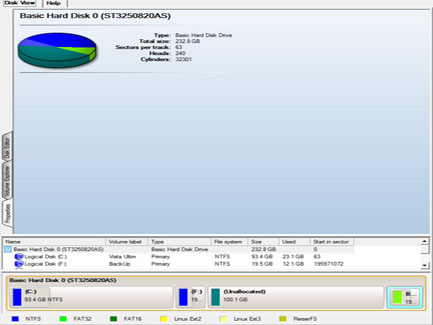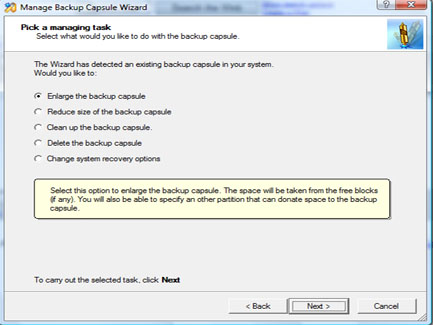Paragon Hard Disk Manager Suite 2008
System Requirements:
Pentium Processor 300MHz or higher, 128MB RAM,
(256MB for Recovery CD, 512MB for Windows OE
Recovery CD) 80MB free Hard Disk space, Windows
2000/XP (Home & Professional)/Vista (32 Bit)
Windows Vista’s disk management tools are
adequate to say the least. Microsoft certainly
wouldn’t be given top marks for effort in this
section of the Vista operating system. Okay compared
with earlier versions of windows, Vista now has the
option of extending and/or shrinking a partition and
better facilities for backing up files, although you
do need the Business or Ultimate versions of Vista
to completely image your hard drive; however both
these options are nowhere near what can be achieved
with third party hard drive management tools such as
Paragon Hard Disk Manager Suite 2008.
Five Utilities
Paragon Hard Disk Manager Suite is a complete set
of maintenance tools consisting of five essential
utilities; they are as follows:
- Protect Your System and Data.
- Maintenance.
- Rescue and Recovery.
- Securely dispose of hard drive.
- Advanced options.
Options Galore
Click on any one of the main menu categories and
an alternative set of options appear to complete the
job. These accompanying set of options takes the
form of links to other built in utilities. For
instance, click on Protect Your System and Data and
you will be offered links to enable the backup
and/or restoration of your system. While links
adequately do the intended job, they do, sadly, tend
to cheapen the look of the application. While links
are extremely useful for websites I feel buttons
would have been more appropriate for this main menu
and, certainly far more appealing.

Fig:1 Hard Disk Manager's Main Menu
When backing up the contents of your hard drive
you have the option of either backing up to a secure
partition – better known as a backup capsule –
created by HDM or copy and burning the files or
image to a set of CDs or DVDs.
Maintaining Your System
Maintenance is the key to a stable system and one
essential maintenance job that should never be
underestimated is defragmenting the drive.
Defragmenting the hard drive is extremely
important. A correctly defragmented hard drive helps
increase the PCs performance by ensuring that all
relevant parts of a file are stored together, rather
than being scattered over the surface of the drive.
The defragmenting utility in HDM is not unlike other
third party defragmentation tools with the exception
that when defragmenting the system drive the
application is forced to use the pre-windows
environment. This I found to be rather an
inconvenience considering that Microsoft’s own
defragmenter, along with many third party
defragmenters such as PerfectDisk, Diskeeper, etc
can defragment a system drive without the need to
boot to a pre-windows environment. Surprisingly i
also found that HDM’s defragmenter took considerably
longer to defragment than other well known brands.
Defragmenting a 100GB system drive, for example,
took well over an hour with HMD, while PerfectDisk
took merely 27 minutes.

Fig: 2 Defragmenting the hard drive
As well as defragmenting the drive the
maintenance option also allows the user to copy the
system drive along with all its data and then
migrate it to a new drive. This is an essential
utility if, for example, you decide to upgrade to a
larger hard drive. Rather than re-installing Windows
and all your applications from scratch on a new
drive you can simply migrate the data using this
utility. The old drive can thus either be disposed
of or, if it is in good working order, pressed into
service as a second or backup drive.
To The Rescue
While it is an easy matter to backup or restore
an image to a hard drive, it is not usually all that
easy to pick out single files or folders for
restoration. With the Rescue and Recovery option of
HDM you have just that option. By clicking on the
Transfer File option you can back up individual
files by selecting them from the available list.

Fig: 3 Transfer files from the right hand pane
to the clipboard pane on the left.
From here on it is just a matter of saving the
files to another drive or CD or DVD. Restoring files
is just as easy. Just open the Rescue and Recovery,
select the location of the backup files, select the
file(s) you want and then restore them to their
original locations.
Disappearing Act
At some point your PC is either going to become
outdated or else pieces of the hardware are going to
start to fail. Inevitably, the point will arrive
where you will want a brand new all singing all
dancing model, with all the latest bells and
whistles. However, once you have splashed out on
your new computer you are faced with another
dilemma, what to do with the old one?
Well you have two choices: you can dump the
machine at the local recycling centre, or you can
give it away to a deserving cause or relative. Both
options are admirable; however, aren’t you
forgetting something? What are you going to do about
all the sensitive data already stored on the hard
drive? How are you going to remove it so no one else
can access it?
Your first and most obvious thought is to
re-format the drive. Well, of course, that is one
solution – probably not the best, but a solution at
any rate. The problem with just formatting a drive
is that anyone with knowhow and the correct software
can easily resurrect every piece of data that
previously existed on the hard drive.
The Securely Dispose of Hard Drive option has its
own solution – Disk Wiper. This enables the user to
completely obliterate any sensitive data stored on
the hard drive, firstly by formatting the drive and
then by randomly writing 0’s and 1’s over the whole
surface of the drive platter(s). This completely
removes all data on the hard drive enabling you to
pass on or dispose of the drive knowing that if the
drive ends up in the wrong hand the person(s) who
obtain it are not going to be able to access any
sensitive data on the drive. The drive will simply
be blank.
Advanced Options
The final menu category of the HDM Suite is
Advanced Options. From within this section you can
do all of your partitioning work, from creating a
partition to resizing and deleting un-necessary
partitions.

Fig: 4 Partitioning is really easy with Paragon
Hard Disk Manager Suite 2008
As stated at the start of this review HMD relies
upon a backup capsule to protect any images of your
hard drive. When you first create a backup capsule
you allocate it a specific size. Obviously, over
time, you may make incremental backup which,
inevitably fill the available space allocated to the
backup capsule. By checking the options available in
the Manage Backup Capsule section you will be able
to make adjustments to the backup capsule by either
enlarging or, if necessary, decreasing the size
allocated to the capsule.

Fig: 5 Make adjustments to the Backup Capsule
using this wizard
The final advanced option is Boot Manager. This
enables anyone running multiple operating systems to
choose which operating system to boot to. With most
dual boot operating system users nowadays preferring
virtual machine software, the use of third party
boot managers is somewhat on the decline. However,
if you don’t want to use virtualisation software,
the boot manager option can be a useful addition to
your arsenal of maintenance tools.
Verdict
Paragon Hard Disk Manager 2008 contains a
complete set of maintenance tools designed
specifically to keep your hard drive in tip top
condition. Regardless of whether you simply need to
partition your hard drive, clone or image a drive,
defragment or securely erase the drive contents
Paragon Hard Disk Manager Suite 2008 has a utility
to complete the job; making it an essential addition
to ever computer users’ tool kit.
Rating:
- Ease of Use: 8
- Features: 9
- Value for Money: 9
- Overall: 9